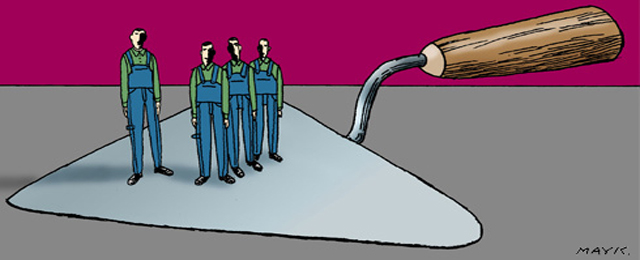Germany already set a record with 41.6 million workers past year. In 2013 it is expected to close the year with an increase of 235,000 employed people and an jobless rate of 6.9%, according to an official autumn report. For 2014 an additional 180,000 jobs are expected to be created, reaching the record figure of 42 million workers and an unemployment rate of 6.8%, despite considerable net migration and the continuing trend increase in labor market participation.
The last Bundesbank’s outlook for the German economy for 2014 and 2015 supports these numbers. Real GDP in Germany could grow by 1.7% in 2014 and 2% in 2015, following an increase of 0.5% in 2013, according to the Federal Bank. “The German economy is in good shape: the unemployment rate is low, employment is rising, and wage growth is returning to normal,” Bundesbank president Jens Weidmann said.
While Europe’s most powerful economy is creating jobs, the other member states in the Eurozone are reaching scary unemployment records. In France, the unemployment rate was of 10.9% on 3Q and through to mid-2014 it should increase by 0.1%, up to 11.0%, the worst since 1997 4Q, according to the French Institute of Statistics and Economic Studies (INSEE).
Italy and Spain, the third and fourth largest economies in the Eurozone, are each still struggling with severe crisis and their unemployment rates continue to be high- 11.3 and 25.98%, respectively. According to the EU Commission forecast, “unemployment in Spain is projected to fall gradually over the forecast horizon, as the labor force continues to shrink and employment destruction reaches a turning point in the course of 2014” meanwhile in Italy it will reach a peak of 12.4%.
In Germany, the labor market reforms introduced by former Chancellor Schröder between 2003-2005 were the beginning of its job miracle. “There was a big imbalance in the development of the wages – while wages in southern Europe were rising over the last years, wages in Germany were stagnating or decreasing. The result: big trade balance surplus for Germany, a huge economic imbalance,” says Claudia Falk, head of Public Interest Unit from the Confederation of German Trade Unions (DGB).
The Institute for Macroeconomics and economic research (IMK) has proposed a rise in German wages of 3% annually over the next few years to boost European economic situation through increasing imports from European countries in crisis.
Nonetheless, one of the most significant points from the CDU-SPD coalition contract is the introduction of a minimum wage of €8.50 (about $11.60) an hour. That “could be one factor to stabilize the level of German wages in general and this would be helpful to reduce trade balance surplus,” explained Claudia Falk. But with legal minimum wage or not, these changes will not be introduced until 2015 and completely applicable until two years later. Therefore, Europeans should continue looking for the growth engine outside Europe.






Be the first to comment on "Germany Employment Rate Shows a Brighter EU Face"